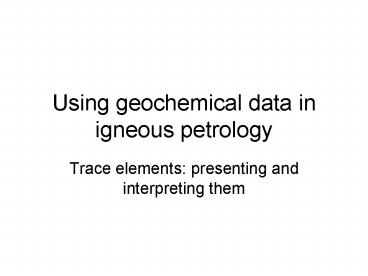Using geochemical data in igneous petrology - PowerPoint PPT Presentation
1 / 50
Title:
Using geochemical data in igneous petrology
Description:
Partition coefficients and bulk repartition coefficient (Kd and D) ... Nb and Ta (Nb/Ta chondritic 15-20, less for crustal rocks) Zr and Hf (Zr/Hf chondritic 30-35) ... – PowerPoint PPT presentation
Number of Views:687
Avg rating:3.0/5.0
Title: Using geochemical data in igneous petrology
1
Using geochemical data in igneous petrology
- Trace elements presenting and interpreting them
2
- Trace elements
- Partition coefficients and bulk repartition
coefficient (Kd and D) - Representing trace element compositions the use
of spidergrams - Main families of trace elements
- The use of ratios
- Some diagrams using trace elements
3
Selective affinities
4
- Partition coefficient Kd Cs/Cl
- Compatible, incompatible (relative to a mineral)
- Bulk repartition coefficient D S Kdi Xi
5
Compatibility depends on minerals and melts
involved. Which are incompatible? Why?
6
- Calculate DYb for
- A lherzolite (80 Ol, 10 Opx, 10Cpx)
- A Grt-bearing Lherzolite (70 Ol, 10 Opx-Cpx-Gt)
- Calculate DSr for
- A Cpx-Plag cumulate (50/50)
- A Cpx-Opx cumulate (50/50)
- How will the residual liquid evolve?
7
4.2 Spidergrams
- Also (better) known as multi-elements diagram
- Allow to represent the whole composition of a
sample on a single diagram - Allow to compare the concentration in elements in
different ranges - Allow to get rid of the effects of primordial
abundances
8
Elements abundance patterns in Earth are a
product of
- Nucleosynthesis
- Lights gt Heavies
- Even gt Odd
- Abundance peak close to Fe (n56)
- Differenciation
- Lithophile mantle ( crust)
- Siderophile core
9
Solar system abundance
10
Concentration of REE in a sample
11
(No Transcript)
12
(No Transcript)
13
(No Transcript)
14
Chondrites
15
Contrasted REE patterns
Granites
Basalts
16
Multi-elements diagrams
Normalized to the PRImitive Mantle (close to
chondrites) (Wood version)
17
Various normalizations
To MORB (Mid-Oceanic Ridge Basalts the most
common type of basalt!) Meaningful for basalts
and co.
Look how the elements on the left-hand side
behave in a different way as those on the
right-hand side!
18
Various normalizations
To the average continental crust. Meaningful for
granites, sediments, etc.
19
4.3 Families of elements
20
(No Transcript)
21
Commonly used trace elements
- LILE Large Ion Lithophile Elements
- Cs, Rb, K, Ba, Sr, Pb
- Large atoms with a small charge
- Tend to be incompatible to very incompatible
- Some exceptions (Rb in Biotite, Sr in plag)
- Typically fluid mobile (and therefore can be
subject to weathering) - Interesting to use but some caution should be
exercised
22
- HFSE High Field Strength Elements
- Sc, Y, Th, U, Pb, Zr, Hf, Ti, Nb, Ta
- Variable behaviours, generally incompatible
except in some specific phases (Y in Grt, Nb in
Hbl) - Normally fluid immobile, insensible to weathering
- Regarded as good petrogenetic indicators
23
- HFSE some interesting pairs with very
similar behaviours - Nb and Ta (Nb/Ta chondritic 15-20, less for
crustal rocks) - Zr and Hf (Zr/Hf chondritic 30-35)
- Values largely departing from this call for
explanation (phases able to fractionnate Nb from
Ta or Zr from Hf)
24
OIB vs. Island-arcs LIL and HFS elements
Figure 16-11a. MORB-normalized spider diagrams
for selected island arc basalts. Using the
normalization and ordering scheme of Pearce
(1983) with LIL on the left and HFS on the right
and compatibility increasing outward from Ba-Th.
Data from BVTP. Composite OIB from Fig 14-3 in
yellow.
Figure 14-3. Winter (2001) An Introduction to
Igneous and Metamorphic Petrology. Prentice Hall.
Data from Sun and McDonough (1989) In A. D.
Saunders and M. J. Norry (eds.), Magmatism in the
Ocean Basins. Geol. Soc. London Spec. Publ., 42.
pp. 313-345.
25
- REE Rare Earth Elements
- La Ce Pr Nd (Pm) Sm Eu Gd Tb Dy Ho Er Tm Yb Lu
- Technically they are HFS
- Rather incompatible, except in specific phases
- For a given mineral phases, different REE have
different behaviours - Nearly insensible to weathering
- Excellent petrogenetic indicators!
26
Kds for REE in basaltic liquids
27
REE the case of Eu
- REEs are normally 3 (La3, etc.)
- Eu can be Eu3 or Eu2
- Eu2 strongly compatible
- Especially in reducing environments
Reducing (Eu2)
Oxydizing (Eu3)
28
- REE ratios
- Eu/Eu is a measure of the size of the Eu anomaly
- La/Yb (or LaN/YbN, also written (La/Yb)N ) is an
indication of the slope of the REE pattern
29
- Transition elements
- Sc, Ti, V, Cr, Mn, Fe, Co, Ni, Cu, Zn
- All compatible, no huge differences
- Low abundances in felsic or intermediate rocks,
useful for basic or ultrabasic systems, or for
some mineral deposits (chromite) - Fluid immobile
30
- PGE Platinum Group Elements
- Ru, Rh, Pd, Os, Ir, Pt, Au
- Not that well-known, large uncertainities on Kds
- Low abudances, commonly below detection limit
(bdl) with usual mehods - Economic importance, especially in chromitites
and sulphides - Marginal petrologic use, could become more
significant in the future
31
4.4 Trace elements ratiosWhy?
- Couple of elements with similar behaviour,
normally not fractionnated and preserved during
most processes - Nb and Ta
- Zr and Hf
32
- A measure of the importance of an anomaly
- Eu/Eu
- Eu/Sm or Eu/Gd (similar to previous)
- Nb/Th, Nb/Ce (Nb-Ta anomaly)
33
- A measure of the shape of a spidergram
- La/Yb, Ce/Yb, La/Lu
- Elements with different behaviours in different
contexts - LIL/HFS to differenciate subduction/OIB, e.g.
Ba/La
34
- Fingerprinting the role of a specific mineral
- Ni strongly fractionated ? olivine gt pyroxene
- Cr ? pyroxenes olivine
- Ni/Cr can distinguish the effects of olivine and
augite in a partial melt or a suite of rocks
produced by fractional crystallization
35
Trace elements ratiosHow?
- Element-Element diagrams with linear scale
36
Trace elements ratiosHow?
- Element-ratio diagrams with linear scale
37
Trace elements ratiosHow?
- Element-element diagrams with log scale
Nb/Ta15
Nb/Ta20
Nb/Ta50
Nb/Ta10
Nb/Ta5
Nb/Ta1
38
Trace elements ratiosBe careful!
- Dividing by a common value yields spurious
correlations
39
4.5 Some trace element diagrams
- In general, far greater diversity than for majors
- You can plot anything against anything else, and
then start again with ratios - Its easy to get confused
40
Some starting points/suggestions
- Diagrams using rare elements (Ni in a granite, Rb
in peridotites) will be highly sensitive to
analytical uncertainities, sampling conditions,
contamination, etc. - Diagrams using elements from the same groups are
likely to give similar results (e.g. Sr and Ba,
Nb, Ta and Zr ) and are somehow redundant to
discuss magma evolution
41
- Use ratios of similar elements (supposedely not
fractionnated during common petrogenetical
processes) to differenciate between different
groups of otherwise similar rocks
In this case low Nb/Ta vs. High Nb/Ta (and,
well, variable Nb/Ta)
42
- Look for correlations ( trends ) or different
populations (different sources or petrogenetic
history?) - Check if trends or grouping are robust in other
diagrams with similar elements (e.g., replacing
Rb by Th, Sr by Ba, etc.)
43
Some starting points/suggestions
- Differenciation vs. different sources check
using Harker type plots what is related to
differenciation!
44
- Two populations distinguished with Rb and Sr
(high Sr, and low Sr) ?
45
- A Harker-type diagram reveals that the Sr
contents whatever the rock type are more or
less correlated to differenciation. The two
groups simply reflect more or less
differenciated rocks from the same series!
On the other hand, the low Rb, low Sr groups
seems to have an independant existence
46
- You will progressively learn, and get used to
certain elements youll be familiar with
typical values, behaviours, etc.
47
- My personnal favorite subset (NB I work on
granites!) - LILE Rb, Sr (used to trace plag, Bt, etc.)
- Th and Cs are too sensible to weathering and
anyway more difficult to analyse not always
possible to have data - HFSE Y (useful for Grt, amp) Nb
- Zr is too affected by zircon Hf and Ta are not
always analyzed (good to look at Nb/Ta and Zr/Hf,
though) - REE La (or Ce), Yb, Eu/Eu
- This carries effectively most of the useful
information - No transition elements, no PGEs
- Too low to be meaningful
- Your own choice will be different (especially if
working on basalts)
48
Classical diagrams
- Spidergrams
- Harker type diagrams
- Check the litterature for your type of rocks
there are some classical diagrams that people are
used to. - e.g. TTG and Archaean rocks Sr/Y vs. Y, La/Yb
vs. Yb (Martin 1987) - Basalts (MORB) La/Sm, etc.
- Island arcs HFS/LIL (Ba/La) etc.
- Geotectonic diagrams (to be discussed next week)
49
Classification based on trace elements
Pearce diagrams (for granites)
50
Classification based on trace elements
Wood diagrams (for basalts)































